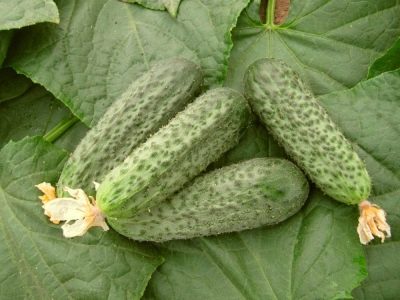
- Authors: Nunhems
- Name synonyms: Bettina
- Year of approval: 2010
- Growth type: indeterminate
- Branching: the average
- Fruit weight, g: 60-80
- Fruit length, cm: 10-12
- Fruit color: dark green with short stripes
- Cucumber Mosaic Virus Resistance: stable
- Ripening terms: early
The Bettina hybrid cucumber variety was bred in Holland, like many other varieties. But this one has characteristics that other cultures cannot compete with. Among them are the shortest ripening times, high resistance to various weather conditions, major ailments, as well as unpretentious care.
Breeding history
The Bettina variety was born relatively recently. Employees of the famous breeding company Nunhems, located in the Netherlands, received the hybrid in 2007. The Dutch scientists set themselves the goal of ensuring that the new crop showed high yields in various, especially in unfavorable climates.
The result exceeded the expectations of the breeders, and Bettina, in addition to excellent resistance to temperature fluctuations, shows a record-breaking ripening period. In 2010, the Dutch hybrid joined the ranks of Rosreestr and is recommended for cultivation almost throughout the country.
Description of the variety
Cucumbers from Holland with the beautiful name Bettina represent the gherkin group of vegetables. As already mentioned, this culture is early maturing. Farmers appreciated this hybrid variety because of the opportunity to harvest in open and closed ground, in greenhouses and greenhouses, even on a balcony or at home, on a windowsill. A characteristic feature of the culture is also the absence of the need for pollination, since this cucumber is of the parthenocarpic type.
According to the reviews of gardeners who managed to try to grow this variety, Bettina demonstrates the best yields by growing in good conditions in the middle zone, but can easily withstand significant temperature fluctuations.
Characteristics of the appearance of plants and zelents
The Bettina hybrid is an indeterminate plant in which the ovaries will be predominantly formed on the main stem. The bush of the culture under consideration is of medium branching. The foliage is painted in light green tones, the plates are medium, but in greenhouses they are larger. Female flowers predominate. In this case, the leaf sinuses contain from 1 to 3 ovaries.
Zelentsy gherkin type, resemble a cylinder in shape. Cucumbers have tubercles, as well as thorns, black pubescence is observed. Gherkins grow 10-12 centimeters long, and average weight 60-80 g.
The color of the cucumbers will depend on both the frequency of irrigation and the type of soil. Under normal conditions, the skin is dark green in color. If the soil is acidic, you can see stripes or spots of yellow color on the skin, but this color is the norm.
Purpose and taste of fruits
The flesh of Bettina gherkins is characterized by juiciness, characteristic crunch, while bitterness, as well as voids are completely absent, and all these qualities are preserved even after heat treatment, that is, during conservation. Since it is a hybrid, the seeds are either small and soft, or none at all. Therefore, gherkins are eaten fresh with pleasure.
Maturation
Bettina is an early ripening cucumber culture. The first harvests are possible 40 days after germination.
Yield
The average yield of Bettina is 5.0 kg / m2, the maximum is up to 7.0 kg / m2.
Growing regions
Rosreestr zoned Bettina for almost most regions of the Russian Federation. Cucumbers from Holland grow well in the northern and northwestern, Volga-Vyatka regions, in the center and the Central Black Earth Region, in the North Caucasus. And also this is the Middle, Lower Volga, the Urals, all of Siberia, the Far East.
Growing and care
It is preferable to cultivate a hybrid Dutch variety on light soils, where there is no lack of moisture. One square meter of a vegetable garden or greenhouse can fit up to three bushes. Lack of lighting will not affect the crop yield at all. And also it is not necessary to perform the formation of bushes.
For irrigation, the best way is drip. But after each watering procedure, the soil must be loosened thoroughly. For feeding, the alternation of aqueous solutions of urea and mullein is excellent. The regularity of such events is once every 7 days.

In order to collect strong, tasty and beautiful cucumbers on your site, you need to make top dressing. Lack of nutrients can negatively affect the appearance of the plant and significantly reduce the yield. Fertilize cucumbers with organic fertilizers in combination with mineral fertilizers. With the right balance of these components and adherence to the fertilizing schedule, the cucumber yield will be maximum.
Disease and pest resistance
Bettina is characterized by resistance to cladosporiosis, as well as TMV (cucumber mosaic virus), LMR (downy mildew). But it shows the greatest resistance to powdery mildew of the usual type.

Despite their popularity, cucumbers are often attacked by diseases and pests. From them, cucumber plantings often die before the start of fruiting. In order to prevent this from happening, it is necessary to try to prevent ailments or get rid of them at the very beginning, having studied in detail their causes of occurrence, signs and methods of treatment.





























































































